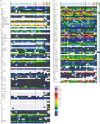Diversity, classification and function of the plant protein kinase superfamily
- PMID: 22889912
- PMCID: PMC3415837
- DOI: 10.1098/rstb.2012.0003
Diversity, classification and function of the plant protein kinase superfamily
Abstract
Eukaryotic protein kinases belong to a large superfamily with hundreds to thousands of copies and are components of essentially all cellular functions. The goals of this study are to classify protein kinases from 25 plant species and to assess their evolutionary history in conjunction with consideration of their molecular functions. The protein kinase superfamily has expanded in the flowering plant lineage, in part through recent duplications. As a result, the flowering plant protein kinase repertoire, or kinome, is in general significantly larger than other eukaryotes, ranging in size from 600 to 2500 members. This large variation in kinome size is mainly due to the expansion and contraction of a few families, particularly the receptor-like kinase/Pelle family. A number of protein kinases reside in highly conserved, low copy number families and often play broadly conserved regulatory roles in metabolism and cell division, although functions of plant homologues have often diverged from their metazoan counterparts. Members of expanded plant kinase families often have roles in plant-specific processes and some may have contributed to adaptive evolution. Nonetheless, non-adaptive explanations, such as kinase duplicate subfunctionalization and insufficient time for pseudogenization, may also contribute to the large number of seemingly functional protein kinases in plants.
Figures



Similar articles
-
Evolutionary history and stress regulation of plant receptor-like kinase/pelle genes.Plant Physiol. 2009 May;150(1):12-26. doi: 10.1104/pp.108.134353. Epub 2009 Mar 25. Plant Physiol. 2009. PMID: 19321712 Free PMC article.
-
ZINC-INDUCED FACILITATOR-LIKE family in plants: lineage-specific expansion in monocotyledons and conserved genomic and expression features among rice (Oryza sativa) paralogs.BMC Plant Biol. 2011 Jan 25;11:20. doi: 10.1186/1471-2229-11-20. BMC Plant Biol. 2011. PMID: 21266036 Free PMC article.
-
Comprehensive comparative analysis of kinesins in photosynthetic eukaryotes.BMC Genomics. 2006 Jan 31;7:18. doi: 10.1186/1471-2164-7-18. BMC Genomics. 2006. PMID: 16448571 Free PMC article.
-
ABC1K atypical kinases in plants: filling the organellar kinase void.Trends Plant Sci. 2012 Sep;17(9):546-55. doi: 10.1016/j.tplants.2012.05.010. Epub 2012 Jun 11. Trends Plant Sci. 2012. PMID: 22694836 Free PMC article. Review.
-
Structure, function, and evolution of plant NIMA-related kinases: implication for phosphorylation-dependent microtubule regulation.J Plant Res. 2015 Nov;128(6):875-91. doi: 10.1007/s10265-015-0751-6. Epub 2015 Sep 9. J Plant Res. 2015. PMID: 26354760 Review.
Cited by
-
Computational identification of receptor-like kinases "RLK" and receptor-like proteins "RLP" in legumes.BMC Genomics. 2020 Jul 3;21(1):459. doi: 10.1186/s12864-020-06844-z. BMC Genomics. 2020. PMID: 32620079 Free PMC article.
-
An update on evolutionary, structural, and functional studies of receptor-like kinases in plants.Front Plant Sci. 2024 Jan 31;15:1305599. doi: 10.3389/fpls.2024.1305599. eCollection 2024. Front Plant Sci. 2024. PMID: 38362444 Free PMC article. Review.
-
Regulatory Mechanisms of Mitogen-Activated Protein Kinase Cascades in Plants: More than Sequential Phosphorylation.Int J Mol Sci. 2022 Mar 25;23(7):3572. doi: 10.3390/ijms23073572. Int J Mol Sci. 2022. PMID: 35408932 Free PMC article. Review.
-
Genome-wide analysis of the transcriptional response to drought stress in root and leaf of common bean.Genet Mol Biol. 2020 Mar 16;43(1):e20180259. doi: 10.1590/1678-4685-GMB-2018-0259. eCollection 2020. Genet Mol Biol. 2020. PMID: 31429863 Free PMC article.
-
A gene-rich fraction analysis of the Passiflora edulis genome reveals highly conserved microsyntenic regions with two related Malpighiales species.Sci Rep. 2018 Aug 29;8(1):13024. doi: 10.1038/s41598-018-31330-8. Sci Rep. 2018. PMID: 30158558 Free PMC article.
References
-
- Hanks S. K., Hunter T. 1995. Protein kinases 6. The eukaryotic protein kinase superfamily: kinase (catalytic) domain structure and classification. FASEB J. 9, 576–596 - PubMed
-
- Hanks S. K., Quinn A. M., Hunter T. 1988. The protein kinase family: conserved features and deduced phylogeny of the catalytic domains. Science 241, 42–52 10.1126/science.3291115 (doi:10.1126/science.3291115) - DOI - DOI - PubMed
-
- The Arabidopsis Genome Initiative 2000. Analysis of the genome sequence of the flowering plant Arabidopsis thaliana. Nature 408, 796–815 10.1038/35048692 (doi:10.1038/35048692) - DOI - DOI - PubMed
-
- Manning G., Whyte D. B., Martinez R., Hunter T., Sudarsanam S. 2002. The protein kinase complement of the human genome. Science 298, 1912–1934 10.1126/science.1075762 (doi:10.1126/science.1075762) - DOI - DOI - PubMed
Publication types
MeSH terms
Substances
LinkOut - more resources
Full Text Sources
Other Literature Sources
Research Materials

